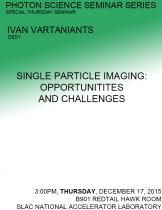Speaker: Ivan Vartaniants, DESY
Program Description
X-ray free-electron lasers (XFELs) may allow us to employ the single-particle imaging (SPI) method to determine the structure of macromolecules that do not form stable crystals [1]. Ultrashort pulses of 10 fs and less allow us to outrun complete disintegration by Coulomb explosion and minimize radiation damage due to nuclear motion, but electronic damage is still present. In this talk results of the study of the effect of electronic damage on the SPI at pulse durations from 0.1 to 10 fs and in a large range of XFEL fluences will be presented [2]. The goal of these studies is to determine optimal conditions for imaging of biological samples. We also study the limits imposed on SPI by Compton scattering.
Another challenge of the SPI is a tremendous amount of data produced in such experiments. It is a great challenge to classify this information and reduce the initial data set to a manageable size for further analysis. In this talk an approach for classification of diffraction patterns measured in prototypical diffract-and-destroy single-particle imaging experiments at XFELs will be presented [3]. These approaches are successfully tested in recent SPI experiments performed by SPI consortium [1].
[1] A. Aquila et al., Structural Dynamics 2, 041701 (2015).
[2] O. Yu. Gorobtsov, U. Lorenz, N. M. Kabachnik, and I.A. Vartanyants, Phys. Rev. E 91, 062712 (2015).
[3] S. A. Bobkov, A. B. Teslyuk, R. P. Kurta, O. Yu. Gorobtsov, O.M. Yefanov, V. A. Ilyin, R. A. Senin and I. A. Vartanyants, J. Synchrotron Rad. 22, 1345 (2015).





